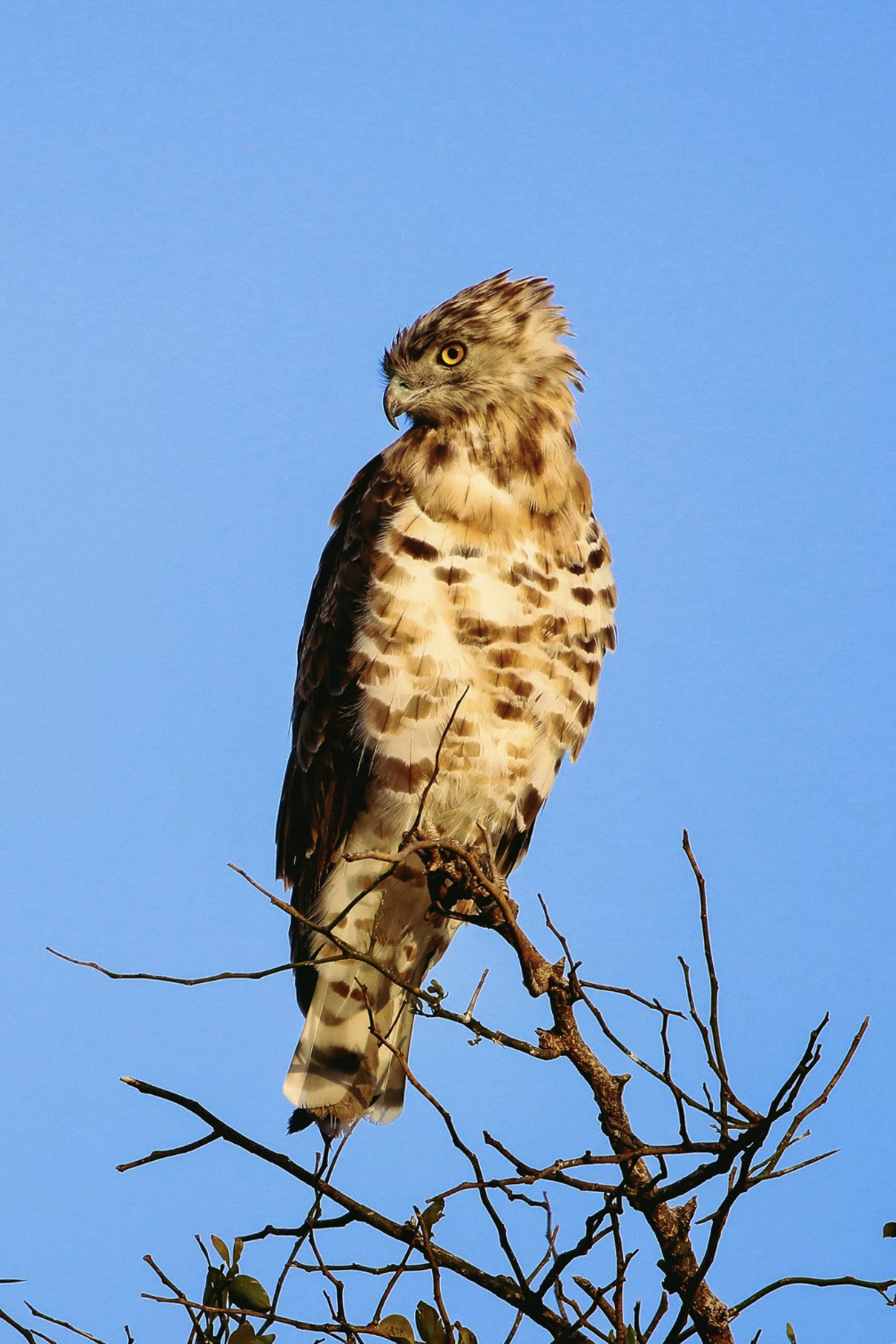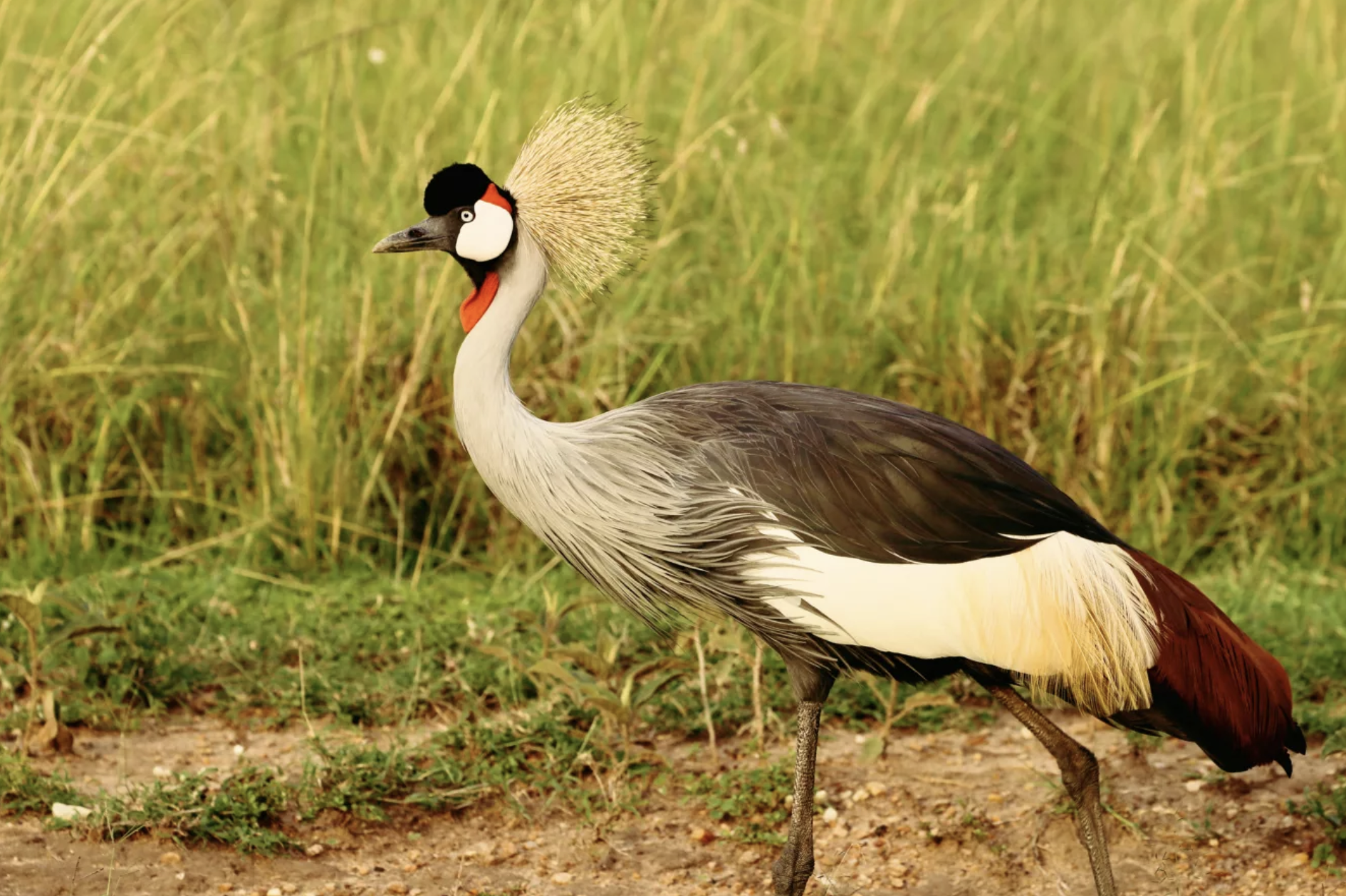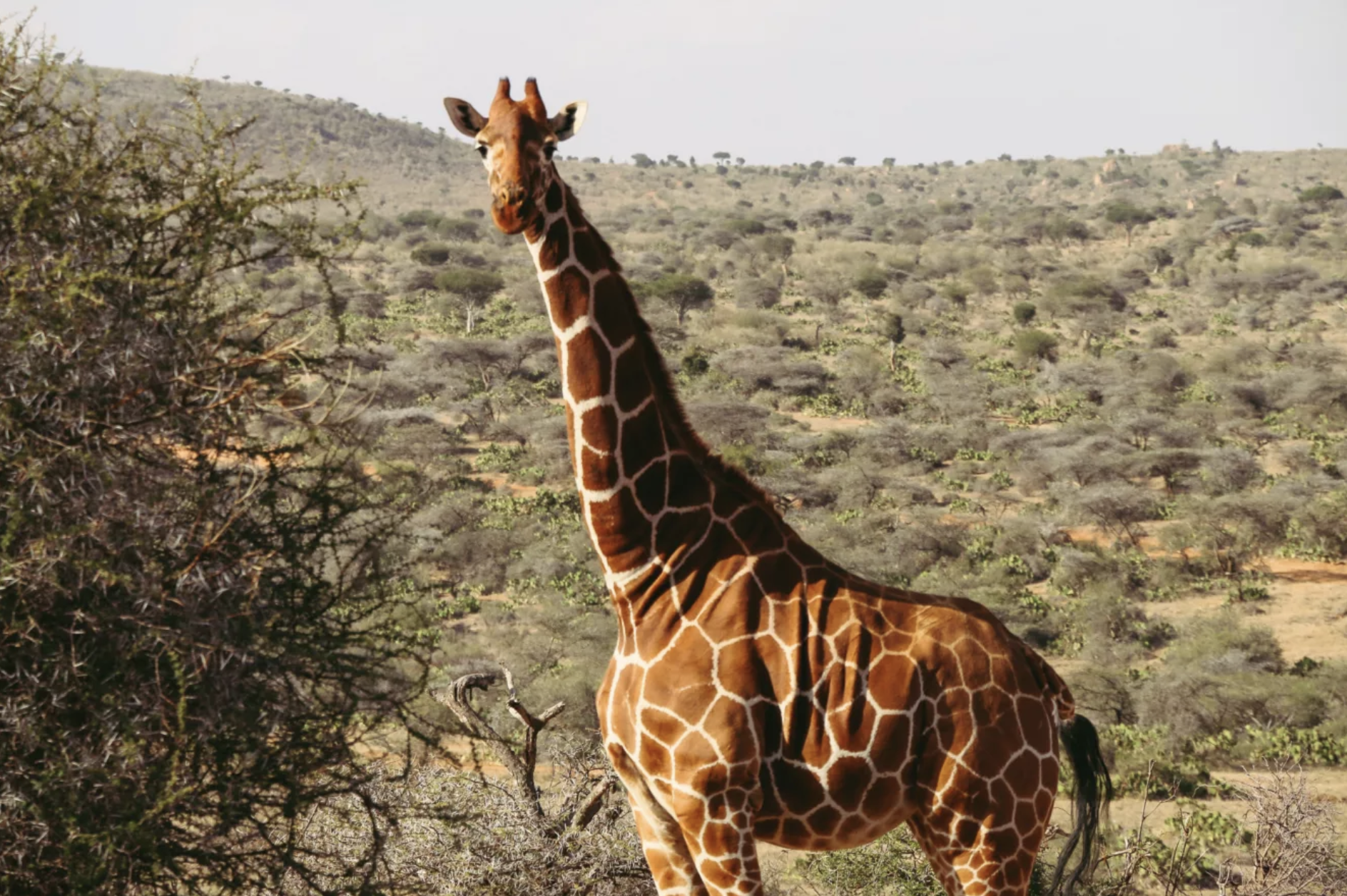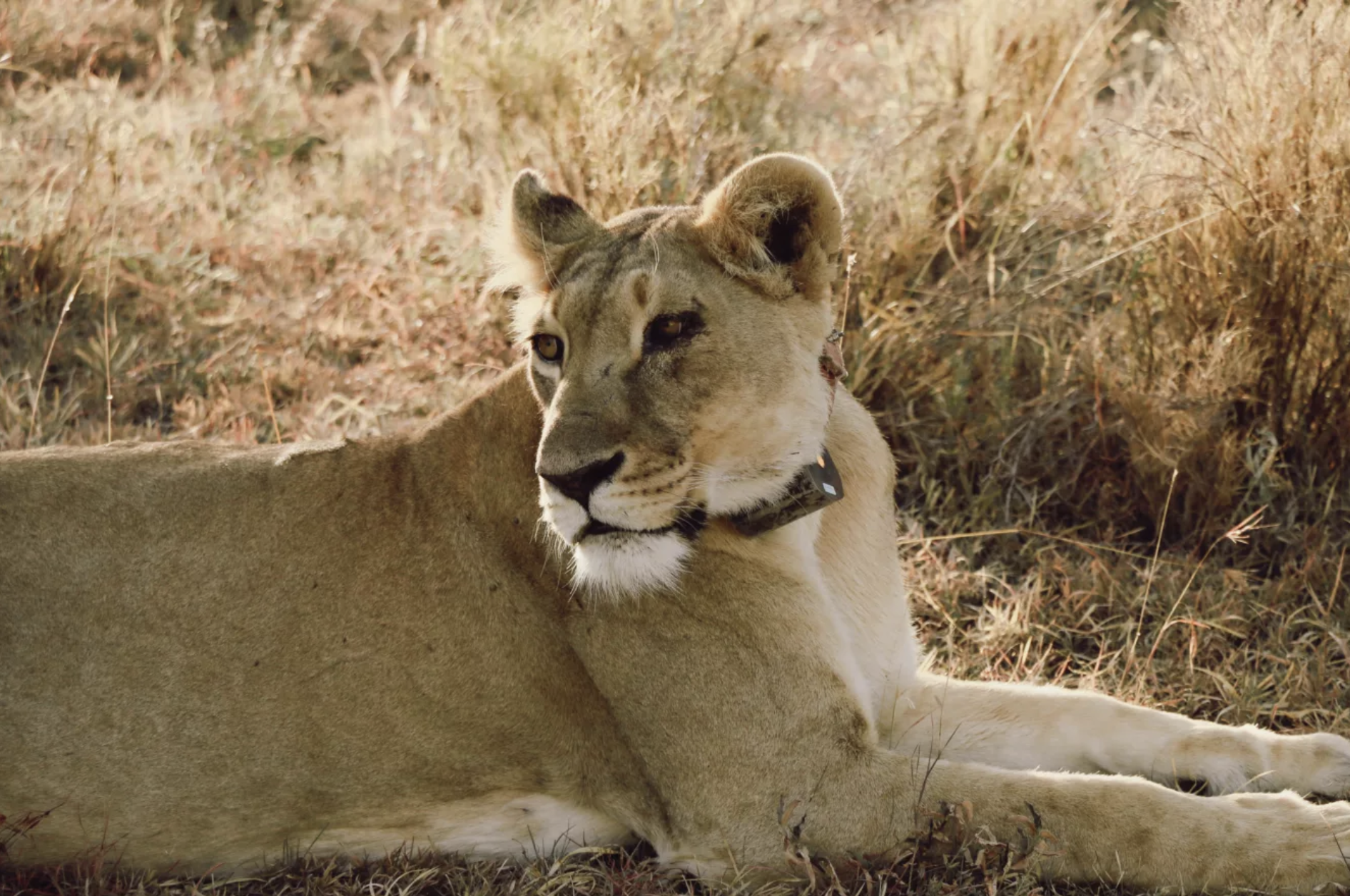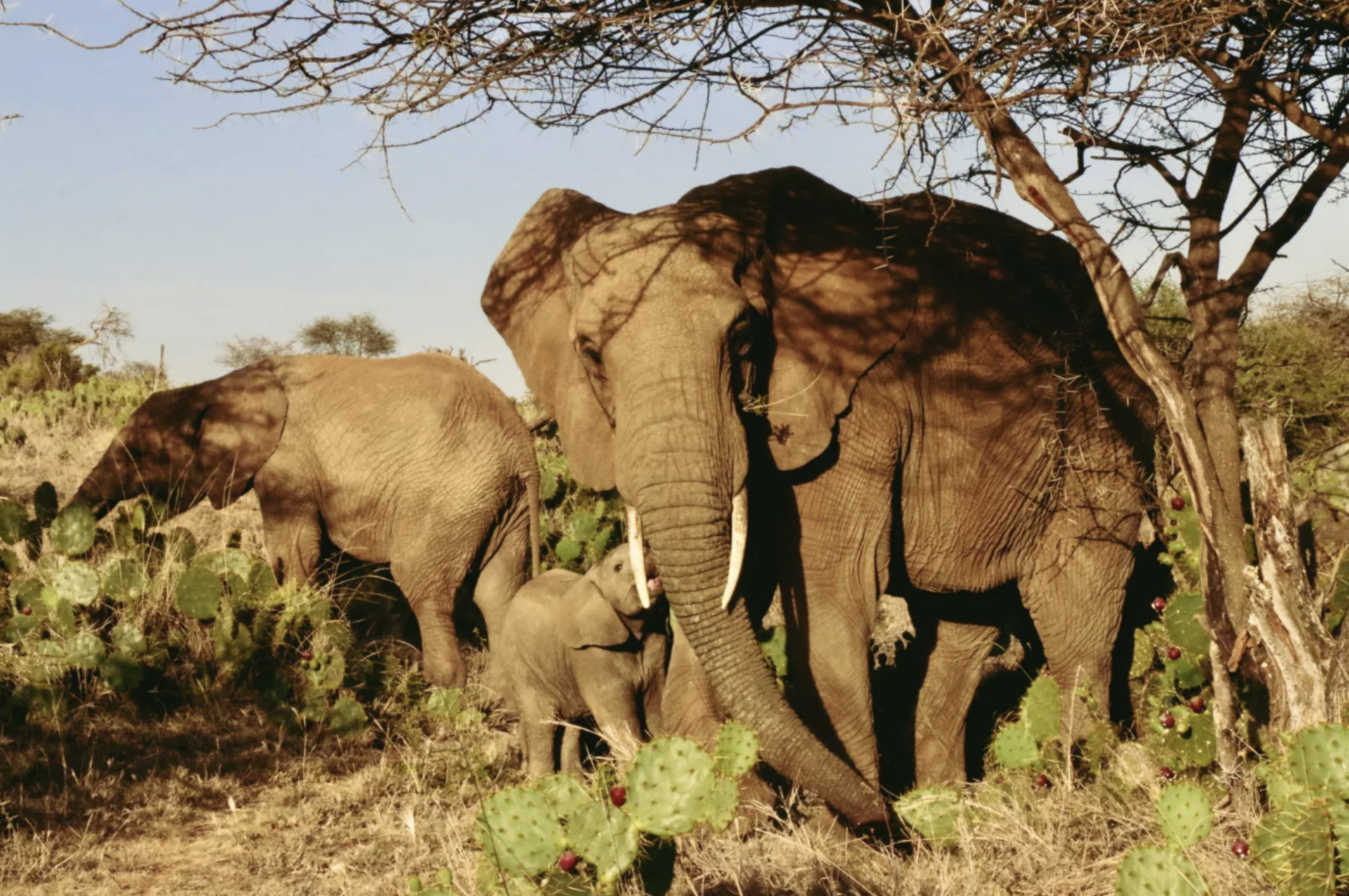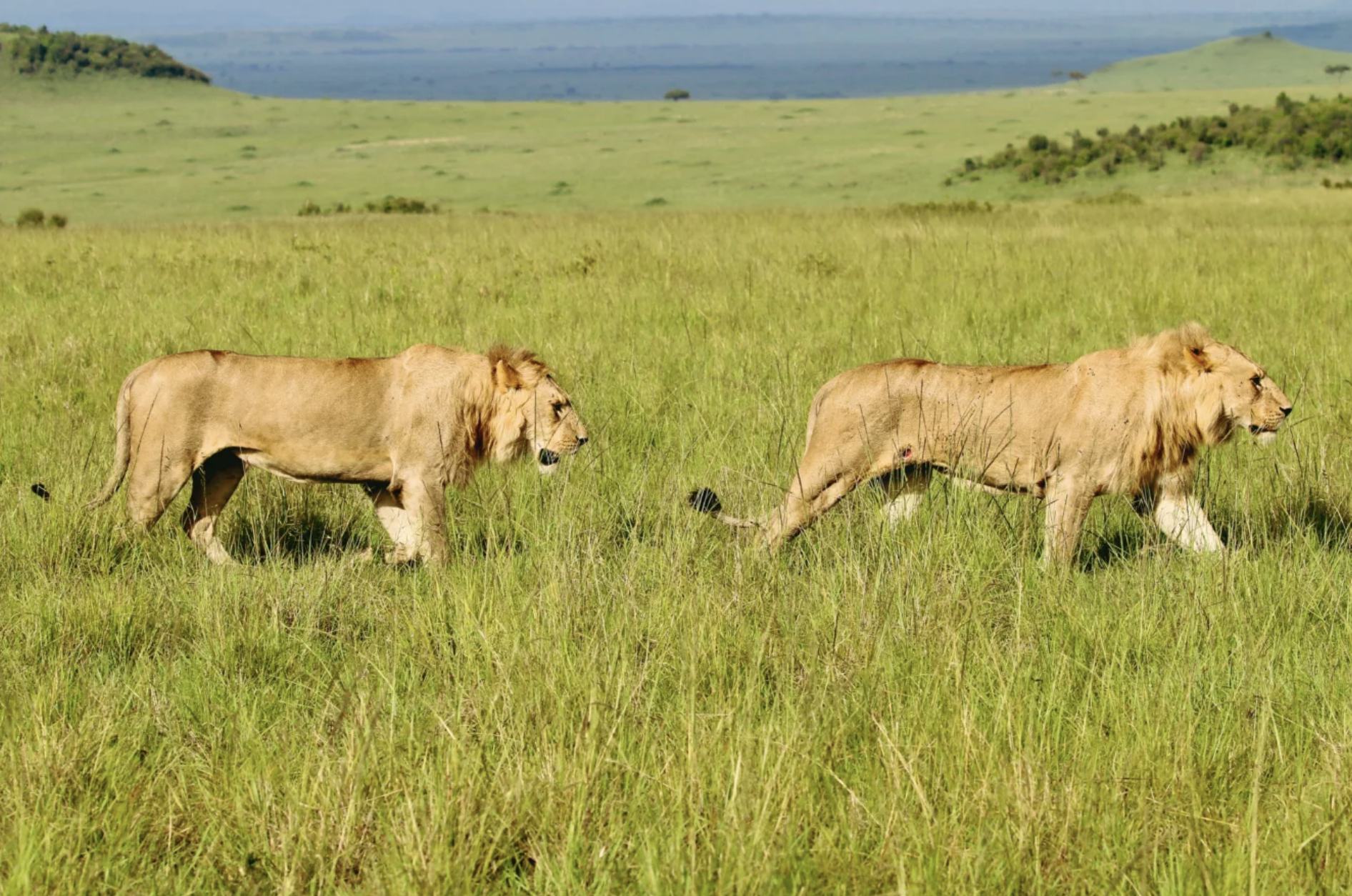Something Wild
A first-time traveler to Africa examines the complicated relationship between safari tourism and conservation.
WORDS BY T. COLE RACHEL, PHOTOGRAPHY BY YAGAZIE EMEZI AND JOSHUA SANCHEZ
HERE’S A THING I never thought would happen. On a beautiful weekday morning a few weeks ago, my partner and I sat down to have a picnic breakfast under the shade of an acacia tree in a remote area of the Maasai Mara in Kenya, just a stone’s throw from the border of Tanzania. We were surrounded by an ocean of green grass and blue sky, save for one perfect tree our guide had parked us under. Just a few days into our trip, the visual stun of the African landscape had still not lost any of its abject wonder. After nearly two years spent safely holed up in our Brooklyn apartment, sipping a cup of coffee while sitting in the tall grass of the Kenya savanna felt like some kind of improbable fever dream. It was at this moment that our guide pointed to something approaching on the horizon. “We have guests,” he said, as two adolescent male lions casually sauntered toward us. Rather than flee, the three of us took our coffee and quietly hopped back into the safari jeep, waiting to see what the lions might do. As our guide predicted, the three of us were of little interest to the enormous cats. They passed by our jeep — within a few mesmerizing feet of us — before finding a spot a few hundred feet away to lie down and sun themselves. Eventually we made our way back to our own picnic, finishing our coffee and granola with two large lions visibly dozing nearby. This, I realized, is why people go on safari. Even as you are experiencing it, it doesn’t feel real.
As a person who grew up in the middle of America, the closest I’d ever come to any kind of exotic animal was at a zoo, an experience I’d always found both thrilling and troubling in equal measure. The conflicted feelings I had about visiting zoos — the lure of seeing incredible creatures up close, balanced against the desire not to contribute to their exploitation or suffering in any way — mirrored my feelings about safari experiences, which were often bound up with ideas about colonialism, cultural appropriation, and a general misunderstanding of the ecosystems in which all of these people and animals must coexist. After visiting Kenya, I’d eventually come to better understand the symbiotic, if fraught, relationship between tourism and preservation that exists throughout much of Africa — a complicated equation in which tourism itself often provides the means for keeping animals safe, land undeveloped, and poachers at bay. The tenuous relationship between commerce and conservation would be put to the test during the pandemic, when, after global tourism came to an abrupt halt, nature conservancies, national parks, and various wildlife trusts throughout Africa would struggle to remain operational.
Depending on your interests, desired level of comfort and accommodation, and what sort of wildlife you want to see, there are a dizzying variety of ways to plan your own safari experience. In plotting my own adventure, I opted to keep things simpler by staying in one country, Kenya, and then sampling, over the course of 10 action-packed days, four very different kinds of safari experiences — all of which operate with an eye toward sustainability and preserving, in every way possible, the very landscape and wildlife you’ve traveled there to see. While I (rightly) expected to have my mind blown by the experience, I did not expect that traveling there would prove so emotional or profoundly humbling. As it turns out, being in close proximity to some of the most incredible wildlife in the world is just as awe-inspiring as you might expect, but it was ultimately the landscape of Africa and the people we met there who would leave the most indelible mark. Even now, weeks after returning home to New York City, I still find myself thinking about this trip almost every day.
Angama Mara’s game drives offer private vehicles.
Hippos, spotted on a game drive, emerge from a bath in the Mara.
Loisaba Conservancy
We start our adventure at the Elewana Loisaba Lodo Springs. Situated high on a hilltop in Loisaba, it is a 57,000-acre conservancy within Laikipia County, owned by Loisaba Community Trust, a Kenyan trust that is committed to wildlife and ecological conservation. As with all the safari experiences that are to follow, we arrive via a dirt airstrip and are picked up by a field guide who will, over the next few days, become our constant companion. Having no idea what to expect, I am taken aback by the landscape — arid, rocky, and punctuated by seemingly millions of prickly pear plants (which, it turns out, are an invasive species that continue to thrive because they are a beloved snack for elephants). Within minutes of landing, we are speeding across the dusty lunar landscape in the back of a safari jeep, pausing to allow for the crossing of a mother giraffe and her baby. At that moment, it seems almost incomprehensible that less than 24 hours before, I’d been sitting at home trying to decide what kind of hat to bring with me (a wide-brimmed bucket hat turns out to be your best bet) and whether my sunblock would be strong enough (it wasn’t).
The basic rhythm of most safari experiences is largely the same — you wake up very early every day to go on a game drive, in hopes of seeing the animals at their most active. After a few hours of being shepherded around via jeep, during which your guide attempts to get you as up close and personal as possible to the wildlife, you return to the lodge for lunch and a nap before eventually heading back out for a late afternoon game drive to essentially do the same thing all over again. Throughout Kenya, the goal of the safari-goer is to see the “Big Five” — lions, leopards, rhinos, elephants, and African buffalos — and to do so with as little fuss or disturbance as possible. We began each day in the predawn, wrapped in blankets and clutching a thermos of coffee, making our way down dusty roads as the most incredible sunrises I’ve ever witnessed gradually illuminated the landscape. Our guide, Festus, not only knew where the animals might be congregating, but he was also an expert field guide, giving us a detailed lesson on the flora and fauna, local geography, and at least some sense of the history of the landscape we were traveling across.
“Every top-tier safari outfit in Kenya is eager to tell you about their sustainability practices: the ways in which they source their food and amenities, and the measures they take to protect the wildlife and to operate in concert with the local tribes.”
By our second day at Loisaba we had already checked all of the Big Five off our list, an experience that culminated with the sighting of a spotted leopard, which slowly crossed our path as if we were invisible, while stalking a gazelle. The experience of seeing the animals, all from the safe (but still unnervingly close) vantage of the safari jeep, never lost its charge. Whether it was a family of elephants casually ripping up a massive prickly pear cactus, a hippo emerging from its mud bath, or a pair of lions dozing in the grass in a postcoital haze, the experience of seeing these creatures at ease in their own native landscape never stopped feeling intensely emotional or, quite frankly, sort of insane.
Elewana has several properties in Loisaba, but since it is a privately owned conservancy, the company has control over the footprint and the number of travelers visiting at any given time. Over the few days we spent there, we rarely saw other guests. On the game drives, it often felt as if we had the entire massive place to ourselves. The lodge accommodations are remarkably luxe, providing a panoramic view of the conservancy and, at almost any given time, visible signs of wildlife. Billed as tented camps, the rooms are essentially incredible suites with tented roofs, giving you the sensation of camping while still providing all the amenities. At night, the rustling of the canvas roof and wooden beams overhead give the sensation of going to sleep in the belly of a massive wooden boat. In the mornings, I am treated to the surreal and moving view of grazing zebras.
At Angama Mara, the Maasai people welcome guests to the lodge. “It’s important that people come here and see how beautiful and happy and welcoming the people are,” said our guide, Festus.
Lions at Maasai Mara National Reserve
Every top-tier safari outfit in Kenya is eager to tell you about their sustainability practices: the ways in which they source their food and amenities, and the measures they take to protect the wildlife and to operate in concert with the local tribes (who often own the land on which the lodges and conservancies are situated). Even so, it’s easy to imagine how visitors here can be insulated, seeing only a carefully curated version of Kenya and the African continent. For this very reason, I was grateful that Festus offered to take us on a drive outside the conservancy to visit a local village and see a community within Kenya beyond the experience tailored for us inside the lodge.
I’m not sure what I had expected to see in this part of rural Kenya, but the experience of visiting the village would ultimately prove to be the most dazzling part of our entire trip, as well as the most humbling. As we approached the manyatta — a small cluster of tiny brick buildings and mud huts — it was apparent that some kind of celebration was taking place. After arriving, Festus informed us that this was a wedding party, and that we had been invited to join. Within minutes, we were welcomed into the celebration — a swirl of dancing, jumping, and singing — and introduced to the bride and groom. I was presented with a cup of fermented honey wine and we were asked into the home of one of the village elders to sit and enjoy our drinks. I found myself totally overwhelmed and emotional, not just by everyone’s kindness, or how incredibly beautiful everyone appeared in all of their wedding finery — layers of beadwork and kaleidoscopic textiles, feathers, and painted faces — but by the sudden outpouring of affection for two American tourists who had just crashed their party. After nearly three years of not traveling due to the pandemic, standing in the middle of this small village and bearing witness to this joyous celebration provided a kind of emotional reset I didn’t even realize that I needed. When I asked Festus to again thank everyone on our behalf for allowing us to join them, he shrugged it off. “It’s important that visitors come here and actually see the real Africa, outside of their resorts and hotels,” he explained. “It’s important that people come here and see how beautiful and happy and welcoming the people are. This is why people should travel, right?”
Maasai Mara
“Sorry, we’re gonna take another pass at this landing. There are water buffalo on the airstrip.” These are words I never thought I’d hear on a flight, but they are how we entered the Maasai Mara, the second stop on our journey. Our wobbly landing, thankfully sans water buffalo, is on a muddy airstrip that is denoted by the hull of an ancient cargo plane parked alongside it. The Maasai Mara is a massive area (some 580 square miles) in southern Kenya, famous for its safari experiences and often touted as the most beautiful game reserve on the planet. We are headed to the Angama Mara Lodge, in what is known as the Mara Triangle, to try out another tented experience. Even after the grand views we’d experienced at Elewana, I was not prepared for what was in store. Angama is a Swahili word meaning “suspended in air,” which makes sense when you actually arrive at the lodge itself. Perched on a cliff overlooking the vast expanse of the Mara, the 15 tented suites here — each outfitted with an entire wall of glass and outdoor porches — offer a view that is unlike anything else I’ve ever seen in my life. While the suites themselves are luxurious, featuring soaking tubs, private bars, and walk-in showers, it’s the view itself that seals the deal. I woke up faced with a sunrise so bright it felt almost psychedelic. We were also greeted every morning by a regular crew of hyrax, small groundhog-like creatures (weirdly enough, they are distantly related to elephants) that live in the rocks, who would often spend the morning sunning on our deck. Every day I had the fantasy of holding one of them up, like Simba in “The Lion King,” and saying, “All of this will one day be yours,” as we both gazed out at the impossible sprawl before us.
Angama is a Swahili word meaning “suspended in air,” which makes sense when you actually arrive at the lodge itself.
For many visitors, the best time to visit the Maasai Mara is during the great wildebeest migration — the time each year when huge herds of animals make their annual trek across the Mara River and head into Tanzania. This is also a time when the reserve is the most crowded with tourists, all eager to see an unlucky zebra snatched by a crocodile while trying to leap across the river. As it turns out, there is really no bad time to visit, as there are animals here year-round (I was frankly relieved, even though we did see crocodiles lurking on the riverbanks, that we didn’t have to bear witness to any deaths). Instead, our daily game drives were pastoral and relaxing — the landscape largely a sea of green grasses — with pauses to look at elephants, photograph exotic fowl (we took a particular liking to the massive secretary birds), get an impromptu botany lesson from our guide, and be stopped in our tracks by large groups of strolling giraffes or, in one instance, by two young lions who were opting to nap in the middle of the road. We gave them their space, choosing to drive around rather than rouse them. While cheetahs proved elusive during our stay, we saw most animals in great numbers — zebras, hyena, gazelle, lions, and more giraffes than I ever could have counted. And no matter how many we saw, or in what amount, being in close proximity never lost its thrill.
Angama offers the most high-end accommodations we were to experience in Kenya (the property boasts a private pool area, a photo studio, a center where you can learn how to create traditional beadwork from local Maasai women, and a restaurant lounge that literally feels as if it is perched on top of the world), and there were also opportunities for going off-site to visit the local Maasai communities. Angama also has its own foundation, which engages various initiatives, in tandem with the Mara Conservancy, to support the local communities in regard to education, health care, and environmental conservation. For visitors who are so inspired, credit card donations to the foundation are easy to make on the premises. Regardless of where you are at Angama, despite the very austere accommodations, the connection to the local landscape — and the people — is always apparent. It’s also the only place where I have enjoyed a Michelin-worthy meal in an opulent restaurant and then been escorted back to my hotel room through a forest by an armed guard, a local Maasai tribesman, just in case there were any wild animals hiding in the dark.
Ol Pejeta Conservancy
Ol Pejeta is a sprawling nature conservancy that is situated right in the middle of Kenya, exactly along the equator. The park is unusual in that it not only includes large expanses set aside for wildlife, but also areas devoted to livestock and agriculture. Aside from the variety of safari and wildlife experiences available (the conservancy also boasts a chimpanzee sanctuary), Ol Pejeta is the largest black rhino sanctuary in East Africa, and is famously home to the two last remaining northern white rhinos in the world. This is a big part of the reason that we’ve come here, as well as the opportunity to spend a couple of days at the Asilia Bush Camp.
Unlike the rocky desert-like terrain at Loisaba or the expansive green grasslands of the Mara, the landscape in Ol Pejeta feels entirely different — scrubby and more dense with wiry trees. The bush camp is situated deep within the conservancy, with tents arranged along the banks of a river. As the name suggests, this is an actual camp and our accommodation is an actual tent, albeit a very nice one. Meals and cocktails are served in a nearby building and one must request hot water, delivered via bucket, to take a shower. Even though the camp life wasn’t quite as luxurious as our previous safari digs (again, guests were encouraged not to leave their tents at night unless accompanied by an armed staff member), there was something extraordinary about being in the bush, among the very animals you’d come here to see. At night after switching off the tent lights, we fell asleep to a cacophony of night sounds — a million indistinguishable bird trills and insect screeches, and mysterious animal rumblings, along with the occasional splash of something slipping into the river just outside our tent. In the morning we were greeted by the sound of vervet monkeys investigating the tent flaps and elephants congregating on the opposite side of the river for a drink. Our morning game drives followed a similar trajectory as our previous excursions, with the exception of a lion-tracking experience in which we used a radar device (which looked like a hand-held TV antenna, held aloft from the roof of the jeep) to pinpoint the location of the lions in the park who had been fitted with tracking collars. After much driving and searching, we eventually located a collared lioness, dozing under a tree with the remains of a recently devoured warthog.
Black-headed heron at Maasai Mara National Reserve
Game drives and tent living aside, the other big draw of Ol Pejeta is the internationally renowned conservation work happening there. (Their motto: “Innovative, tangible, sustainable conservation for wildlife and people.”) The park is famous for its rhino sanctuary (including a blind rescued rhino named Baraka, a gentle giant who eats carrots out of our hands), and for providing safe haven to the last two living northern white rhinos on earth. We are hosted by Samuel Mutisya, manager of the conservancy, to visit the rhinos and to hear more about the great lengths that are being taken to protect them. In addition to keeping the rhinos alive and happy, he details the complicated and costly plans to save the species using in vitro fertilization and a surrogate rhino. It’s a plan that, if successful, could take years to execute and one that, like so many other things, was nearly derailed when the pandemic brought the entire tourism industry to a standstill. “We had to be very creative in order to remain in business, but we were lucky because we have the rhinos here,” he explains. “For everyone working at Ol Pejeta, it wasn’t just about the business; it’s literally about trying to avoid an extinction event. It’s about trying to avoid keeping these animals from totally disappearing.”
“The idea that we are spending time with the two last living creatures of their kind is almost incomprehensible to me.”
On our last afternoon at the conservancy, my partner and I are driven out to visit the two northern white rhinos, Najin and Fatu, who spend their days roaming in their own private paddock near the conservancy offices. Though they are free to wander outside in the daytime, the two are ushered indoors at night for their own protection. The rhinos have armed guards 24 hours a day, which strikes me as simultaneously remarkable and somehow incredibly sad. We are driven out to an enclosure to visit the rhinos along with their trainer and handler. The idea that we are spending time with the two last living creatures of their kind is almost incomprehensible to me. When our jeep stops, the two giant animals slowly approach us, knowing that there will likely be a snack involved. We watch as the handler gets out of the jeep and feeds them by hand. As they eat, we are able to reach out and touch the animals’ backs and the tips of their horns. At that moment, the only thing stranger than the fact that I am somehow in Africa, sharing space with these two incredible creatures, is the idea that they have been hunted to the very edge of extinction. It’s a beautiful sunny day — maybe the most perfect of our trip. As we are driven back to the research center, two rhino security men with machine guns wave goodbye to us. I’m happy, at least, that our tourist dollars are funding something bigger and more important than just our own curiosity.
Baraka, the blind black rhino, at Ol Pejeta Conservancy
Amboseli National Park
The last stop on our safari of safaris is Amboseli National Park, a massive expanse of land that encompasses a boggling array of micro-landscapes — the dried-up bed of ancient Lake Amboseli, sprawling wetlands with bubbling sulfur springs, and stretches of savanna that seem to go on for as far as the eye can see. We only manage to see a fraction of it. Amboseli is synonymous with elephants who thrive here. Without many natural predators and with little threat of poaching, they are living their best lives and, as we quickly see, grow to be particularly huge here as a result. As we arrive, we zoom past marshes filled with thousands of flamingos and have to pause occasionally to make way for the water buffalo and zebra who graze alongside the roads.
We spent our last few days in Kenya at Ol Tukai Lodge, a massive colonial-style building filled with African relics and tribal antiques, providing the most old-school safari aesthetic of any place we visited. The rooms are housed in bungalows surrounding the main lodge, which itself is ensconced by perfectly manicured lawns home to an assortment of monkeys who roam the grounds day and night. The accommodations here are more basic than some of the previous properties we’ve visited (no air conditioning, but lots of mosquito netting), but that’s not what you come here for. The real draw of Ol Tukai are the views, as the entire property looks out at a snow-capped Mount Kilimanjaro. Waking up every morning for our game drives while seeing the sunrise over the mountains — providing the perfect frame for the umbrella acacia trees and roving groups of elephants — was like every episode of “Nature” I’d ever seen on PBS suddenly manifesting in front of my eyes. Every morning, even after nearly two weeks in Africa, I would turn to my partner as we both stared out from the back of the safari jeep and say, “Is this real?”
Given Amboseli’s reputation as a haven for elephants, we made time to visit the Amboseli Trust for Elephants, an organization dedicated to the long-term conservation and welfare of Africa’s elephant population. Founded in 1972 by scientist Cynthia Moss, the trust is now responsible for providing much of what the world now knows about elephant behavior, based on nearly 50 years of research and observation. The trust is headquartered just a short distance away from Ol Tukai and consists of a small, beautifully maintained camp where visitors can come and learn about the elephants and support the work the trust continues to do. We have tea with Norah Njiraini, a training coordinator at the camp who has spent decades living and working on-site. Even though the elephants are free to roam in and out of the park, most of them seem to consider the park their longtime home. After giving us a crash course on elephant behavior and the complicated matriarchal societies in which they operate, Njiraini pulls out a series of photo albums that document the lives and behaviors of the thousands of elephants that live in the park, all of whom she knows by name and can identify on sight. “Elephants are so smart,” she tells us. “They know where they are safe, they remember everything. That’s why they come here. And that’s why I have stayed here, too.” I leave thinking that Njiraini has arguably one of the greatest jobs on planet Earth.
Elephants at Maasai Mara National Reserve
After nearly two weeks of tiny planes, traveling, and endless game drives, I feel slightly exhausted and more than a little melancholy that we’ll soon need to begin the journey back to New York City. Whatever apprehensions I had about the trip — complicated logistics, lingering COVID-19 anxieties, or concerns about what, exactly, our tourist dollars might be helping to support — have been mostly allayed. Instead, I’ve been wowed, not only by the incredible wildlife and mind-blowing nature on display, but also by the kindness of the people we’ve met along the way, and by the hard work being done to ensure this spectacular beauty remains protected.
To celebrate our last night in Kenya, we opt for one last game drive in Amboseli. We head out in the late afternoon as the sun begins its descent, but after several hours of scenic driving turns up little wildlife, our guide reluctantly steers us back toward the lodge. Before we make it back, however, our drive is unexpectedly paused — a group of 11 lions are dozing near the edge of the road. As we slowly approach, so does a large group of elephants, clearly annoyed by the big cats blocking their path. We sit in silence and watch the two groups at loggerheads in front of us — a mixture of lion growls and elephant stomps that seems to go on for ages, neither group willing to cede to the other. Eventually the lions give in, slowly padding their way into the trees. The elephants, with babies in tow, cross the road in front of us. As the sun sets over Kilimanjaro, everyone eventually goes their separate ways, including us.
Every morning, even after nearly two weeks in Africa, I would turn to my partner and say, “Is this real?”










